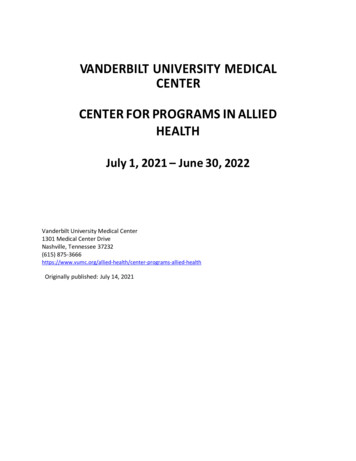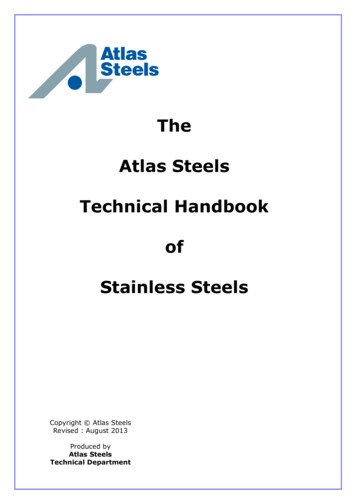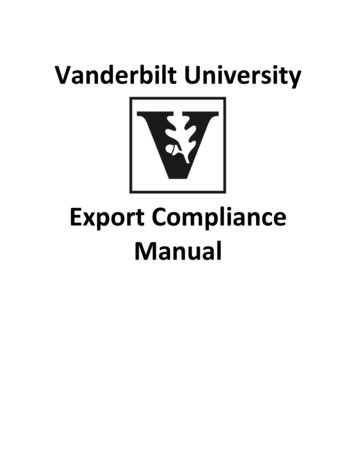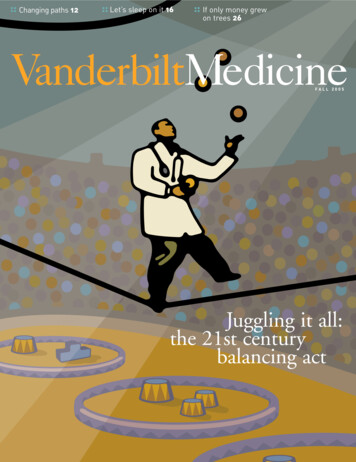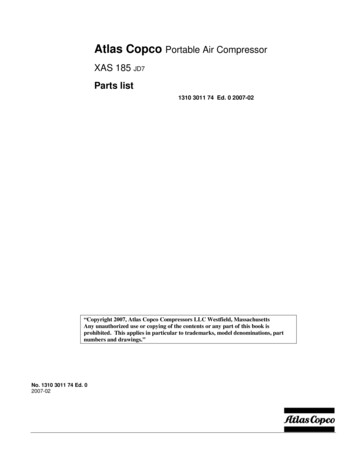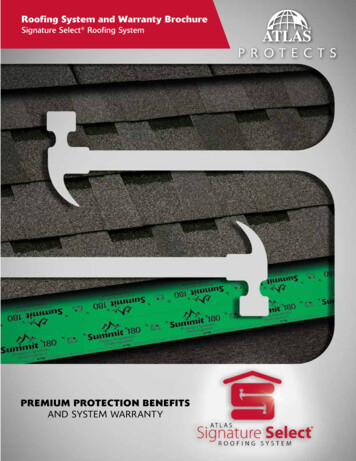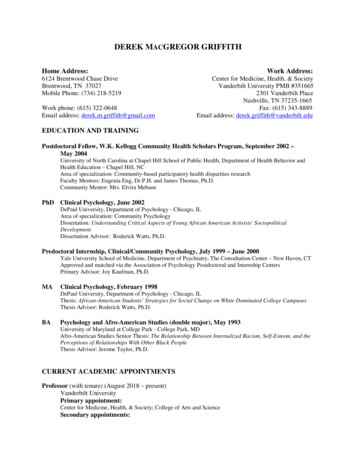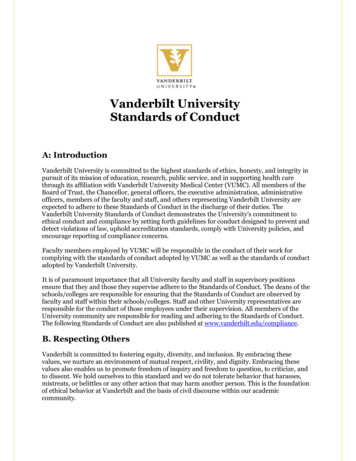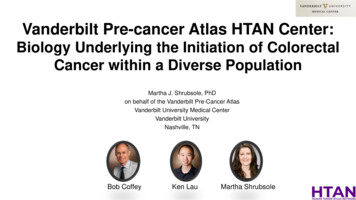
Transcription
Vanderbilt Pre-cancer Atlas HTAN Center:Biology Underlying the Initiation of ColorectalCancer within a Diverse PopulationMartha J. Shrubsole, PhDon behalf of the Vanderbilt Pre-Cancer AtlasVanderbilt University Medical CenterVanderbilt UniversityNashville, TNBob CoffeyKen LauMartha Shrubsole
Challenges and Strategies for Colorectal Cancer Needs Risk stratification – who is at high risk?Improved screening modalitiesEarly detection strategiesPrevention or interception strategies including chemoprevention Potential Solutions Understanding of molecular phenotypes Understanding of progression of adenomas
Pathways to Colorectal CancerPrecursorLesion65-80% of CRCs CIN; MSSConventionalAdenomaSessileSerratedPolyp10-35% of CRCs CIMP; MSI-HDickinson et al. Gut 2015;64:1485-1494Guinney et al. Nature Medicine 2015 Nov;21(11):1350-6
COLON MAP – The Colorectal Molecular Atlas ProjectAn integrative single cell atlas of host and microenvironment in colorectal neoplastic transformationAn NCI Cancer Moonshot ProjectStudy Design 3D modeling for progression of sporadic colon adenoma to colon cancer scRNA-seq for identifying cell state markers Spatial profiling/analysis using MxIF and smFISH Multiregional exome sequencing Biofilm analysis Enrollment of participants from colonoscopy and surgeryBiospecimens Colon tissue: Polyps and normal mucosa Fresh, FFPE, Carnoy’s fixed (for microbial biofilm analysis) TMAs, whole sections Blood, urine, stool, oral swab, oral rinseGoal: Modeling progression ofsporadic colon polyp to coloncancer withspatial information on themicrobiome and host cellsParticipant-Level Data Standardized pathology Diet and lifestyle factors Clinical history and findingsPI UNITBob Coffey, MDKen Lau, PhDMartha Shrubsole, PhDBIOSPECIMEN UNITLead: Martha Shrubsole, PhD, EpidemiologistLead: Kay Washington, MD PhD, PathologistCo-I: Reid Ness, MD, GastroenterologistCo-I: Tim Geiger, MD, Colorectal SurgeonCo-I: Tim Su, MD PhD, PathologistCo-I: Qiuyin Cai, MD, PhD, BiorepositoryCHARACTERIZATION UNITLead: Ken Lau, PhD, scRNA-seqLead: Cindy Sears, MD, MicrobiomeCo-I: Gregor Neuert, PhD, smFISHCo-I: Bob Coffey, MD, MxIFCo-I: Bob Anders, MD PhD, ImmunologyCo-I: Joe Roland, PhD, Digital HistologyDATA ANALYSIS UNITLead: Qi Liu, PhD, BioinformaticsLead: Yu Shyr, PhD, BiostatisticsCo-I: Lynne Berry, PhD, Data DistributionCo-I: Simon Vandekar, PhD, Image AnalysisCo-I: Quanhu Sheng, PhD, Software Engineering
COLON MAP Participants Recruited from scheduled colonoscopies and surgical resections for largepolyps at Vanderbilt Integrated systems to facilitate efficient recruitment of participants, collection ofbiospecimens, and management of data and biospecimens Stratified sampling design to enhance racial/ethnic diversity ( 24%) Surveys for individual-level exposure and health history Biospecimen collection
COLON MAP Tissue Collection Standard of care colonoscopy All polyps removedFreshscRNA-seqBiofilmFrozenColonoidFFPE FFPE for clinical diagnosis Other portion reserved forresearchDiagnosis Collection of 8 normal-appearingcolon biopsies (4 R, 4 L)MxIF, MxIHC Standardized research pathologyreview of all FFPE polyps
ColonarchitectureModels of GI tumorigenesisStem tumorigenic stateNon-stem tumorigenic stateMostly sterile(Spasmolytic polypeptide-expressingmetaplasia - Goldenring and Nomura,2006)(Donaldson et al. 2015)Microbes affects surfaceand crypt cells differentlyBi-allelic APC mutationMetaplasia – transition of adifferentiated cell into regenerative nonnative cell state
Key Questions1. Can we find evidence of analternative origin oftumorigenesis (aside from stemcells) in human colon tumors?2. If so, do these tumors exhibit adifferent immune tone andmicroenvironment?
scRNA-seq co-embedding with normal specimens toidentify transcriptionally abnormal epithelial cellsEpithelial etStemSerratedCyclingTuftBob ChenSerratedConventionalAbnormalTraining set (30 participants; 69 samples; 75,000 cells) 14 adenomas 13 serrated 3 CRC Accompanying normalHist.NormalChen B, Scurrah CR, et al Cell DOI:https://doi.org/10.1016/j.cell.2021.11.031
Adenoma cells (ASCs) and serrated cells (SSCs)exhibit different pathway profilesGenesRegulonsCytoTRACESerrated-specific cells Lack WNT-pathway activation Differentiated cell characteristics(e.g. KRT20) Low inferred stem potentialAD-specific cells WNT pathway activation Transcriptomic profile similar tonormal stem cells High predicted stem potential
Serrated cells activate gene networks related todamage response and metaplasiaMetaplasia Transcriptomically resemble absorptive-lineage cellsbut express selected goblet cell genes (mucins) Enriched for non-colonic genes expressed in otherendodermal organsStemInflammatory Loss of caudal regional identity and re-expression ofembryogenic genesAdenoma Signature for inflammatory response to epithelialdamageSerrated
Top-down or Bottom-up Model of TumorigenesisSerrated PolypsAdenomas
Stem cell expansion and maintenance of caudalidentity in conventional adenomaCDX2 (regional ID)OLFM4 (Stem)MUC5AC (metaplasia)Eliot McKinleyAdenomaSessileSerrated
Evidence of non-stem origin of serrated cells:shared phylogeny with differentiated cellsTubularCytoTRACELGR5 StemConventionalspecificTransit-amplifyingCrypt tiveSessile Serrated
Evidence of non-stem origin of serrated cells:velocity suggests non-stem rrated (sessileserrated)
Metaplastic signatures of serrated polyps are carriedinto MSI-H CRCSerrated Polyps(HP, SSLs)MSI-HCancerASCSSCMSSMSI-HASCSSCDensityMSI subtypeWNT subtypeASCSSCAbnormal epithelial cells
Stem cell program reactivated in MSI-H CRC cellscompared with serrated polyp cells
Lack of stem and metaplastic heterogeneity inMSS CRCMSSOLFM4PCNA
Cytotoxic immune cells are increased inserrated polyps
Geographical differences in the immunecompartment
Functional validation of the tumor cell-differentiationstatus and the effects on cytotoxic immunity1. Braf mutant villiform lesions showincreased CD8 T cell infiltration2. Mist1 tumor cells exhibit reduced stemness and cytotoxicimmune microenvironmentExperimentComp. Prediction(scRNA-seq)****Organoid formation20Lrig1 Tumor******1510521MLrig1Tuis m ot1r(Tu normmor)(Con n ormtrol)(norm)03. Tumor cells exhibit increased expression ofantigen presentation machinery inverselyproportional to stemnessMist1 Tumor
Summary There are tumor-intrinsic differences between conventional and serrated pathways oftumorigenesis Conventional adenomas arise from activation of WNT and associated regenerativeprograms; serrated polyps arise from mucinous metaplasia in response to damage The origin of conventional adenomas are implicated to be normal stem cells;serrated polyps may develop from committed absorptive cells Serrated polyps present a cytotoxic immune environment preceding hypermutation
HTAN Trans-Network Projects (TNPs)Collaborative research projectsacross HTAN centers andsupported by dedicated researchfunds HTAN Diversity and Inclusion Working GroupTo support contributions of research advocates inHTANColorectal LiverMetastasisSARDANA Compare imaging methodsacross centers 7 HTAN centers Vanderbilt Enlisted CHTN for samplecollection scRNA-seq MxIFResearch Advocates Cross-test platforms andmethods and evaluatebiological insights into tumorheterogeneity using sharedspecimens4 HTAN centersTissue CellularNeighborhoods Initiative A gold-standard set of cellularneighborhood annotationsacross tissues5 HTAN centersGoals: Open-source and interoperable tools
Biofilm in CRC TNP Initiated new TNP focused on role of biofilms (BF) in CRC Collaboration with Stanford and WUSTL Malaysia Biofilm Study Led by Dr. Cindy Sears Collection of unique colorectal cancer/tissue samplessuitable for biofilm analysis Characterized by FISH for invasive biofilms TNP: Serial sections of FFPE tumor FISH (JHU) MxIF (Vanderbilt) Nanostring on regions of interest (Stanford)CindySearsJuliaDrewes
Vanderbilt PCA Contributions to HTAN to Date Intentional recruitment plan to optimize diversity Extensive characterization of participants and their biospecimens Generation of largest single-cell RNA-seq dataset of colorectal polyps Deposition of data/publications to DCC and other public resources 15 publications including scientific findings and methods Creation of open source tools (e.g dropkick, MIRIAM) Leadership of multiple working groups within HTAN Initiation of and collaboration in multiple TNPs Training and research opportunities for junior investigators Leverage of other resources to enhance the scientific goals and impact
Human colon cancer-derived C. difficile strains drivecolonic tumorigenesis in germ-free ApcMin/ mice1. Variability in tumorigenic capacity ofbiofilm CRC mucosal slurries2. C. difficile drives tumorigenesis and crypt-invasive biofilmformation of the 3728T isolates (30-bacteria mixture)3728T isos Cd3728T isos -CdEUB338C.difficileDAPI3728T isos -Cd4. Tumorigenesis at 8 wk p.i., and IL-17 andROS induction at 2 wk p.i. is dependent on C.difficile toxin TcdB8 wk GF ApcMin/ Colon tumors3. Cell-specific signatures in mice inresponse to C. difficile slurry (3728T) vs. C.difficile- slurry (3979T) from CRC patientsJie Chen30p 0.00420Nick Markham100TcdB- TcdB 10010010110p 0.002Duox2 (2 ddCt)p 0.006Nos2 (2 ddCt)Il17A (2 ddCt)1000101p 0.0118Julia Drewes6420.100.1TcdB-WTTcdB-WTTcdB-WTDrewes, Chen, Markham Housseau, Lau, Sears 2022 in press Cancer Discovery
Next Steps and On-going Activity Expanded sample size for scRNA-seq MxIF, MxIHC for spatial relationships and methods Follow-up of participants for future outcomes Colonoids Newsletter and lay summaries Application for additional funding to support hypothesis-testing andvalidation in animal models Spatial transcriptomics
Visium Spatial Transcriptomics**SpatialTranscriptomics2. SpatialCommunityDetection3. Quantification andpseudotime mapping1. NMF DeconvolutionSingle-cell RNAseqPseudotime
AcknowledgementsVanderbiltBob CoffeyKen LauKay WashingtonQi LiuYu ShyrTimothy SuWon Jae HuhReid M. NessXiangzhu ZhuQiuyin CaiJohns HopkinsBob ChenEliot McKinleyCody HeiserJoe RolandJeff FranklinSimon VandekarCole HarrisMarisol RamirezNick MarkhamLynne BerryGI DivisionGI Clinical Research TeamCooperative Human Tissue NetworkWestern DivisionMolecular Epidemiology Core LaboratorySurvey Research Shared ResourceTissue Pathology Shared ResourceDigital Histology Shared ResourceEpithelial Biology CenterCindy SearsJulia DrewesFundingU2CCA233291 (Coffey, Shrubsole, Lau)P50CA095103 (Coffey)R35CA197570 (Coffey)R01DK103831 (Lau)P30CA068485 (Pietenpol)UM1CA183727 (Washington)T32LM012412 (Blume, Gadd, Malin)COLON MAP LEADERSHIPOverallBob Coffey (contact PI), Ken Lau, Martha ShrubsoleBiospecimen Acquisition, Processing & Classification UnitMartha Shrubsole, Kay WashingtonMolecular, Cellular & Tissue Characterization UnitKen Lau, Cindy Sears (Hopkins)Data Processing, Analysis & Modeling UnitQi Liu, Yu Shyr
Vanderbilt University Medical Center Vanderbilt University Nashville, TN Bob Coffey Ken Lau Martha Shrubsole. . Participant-Level Data Standardized pathology Diet and lifestyle factors Clinical history and findings . Bi-allelic APC mutation (Spasmolytic polypeptide-expressing metaplasia - Goldenring and Nomura,
